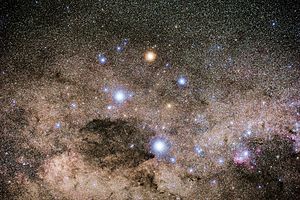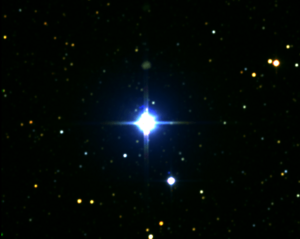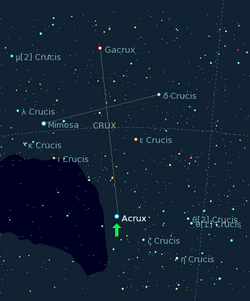Acrux facts for kids
| Observation data Epoch J2000 Equinox J2000 |
|
|---|---|
| Constellation | Crux |
| Pronunciation | /ˈeɪkrʌks/ |
| Right ascension | 12h 26m 35.89522s |
| Declination | −63° 05′ 56.7343″ |
| Apparent magnitude (V) | 0.76 (1.33 + 1.75) |
| Characteristics | |
| Spectral type | B0.5IV + B1V |
| B−V color index | −0.26 |
| Variable type | β Cep |
| Astrometry | |
| Radial velocity (Rv) | −11.2 / −0.6 km/s |
| Proper motion (μ) | RA: −35.83 mas/yr Dec.: −14.86 mas/yr |
| Parallax (π) | 10.13 ± 0.50 mas |
| Distance | 320 ± 20 ly (99 ± 5 pc) |
| Absolute magnitude (MV) | −3.77 (−2.2 + −2.7) |
| Orbit | |
| Primary | α Crucis Aa |
| Companion | α Crucis Ab |
| Period (P) | 75.7794±0.0037 d |
| Eccentricity (e) | 0.46±0.03 |
| Periastron epoch (T) | 2,417,642.3±1.6 JD |
| Argument of periastron (ω) (secondary) |
21±6° |
| Semi-amplitude (K1) (primary) |
41.7±1.2 km/s |
| Details | |
| α1 | |
| Mass | 17.80 + 6.05 M☉ |
| Radius | 7.8 R☉ |
| Luminosity | 25,000 L☉ |
| Temperature | 24,000 K |
| Rotational velocity (v sin i) | 120 km/s |
| α2 | |
| Mass | 15.52 M☉ |
| Radius | 5.4 R☉ |
| Luminosity | 16,000 L☉ |
| Temperature | 28,000 K |
| Rotational velocity (v sin i) | 200 km/s |
| Age | 10.8 Myr |
| Other designations | |
| α1 Cru: Acrux, 26 G. Crucis, FK5 462, GC 16952, HD 108248, HR 4730 | |
| α2 Cru: 27 G. Crucis, GC 16953, HD 108249, HR 4731, 2MASS J12263615-6305571 | |
| Database references | |
| SIMBAD | α Cru |
| α1 Cru | |
| α2 Cru | |
Acrux is the brightest star in the southern constellation called Crux. It is also known as Alpha Crucis. This star is the 13th brightest star we can see in the night sky.
Acrux is the most southerly star in the star pattern known as the Southern Cross. It is also the southernmost first-magnitude star, which means it is one of the very brightest stars. Acrux is about 321 light-years away from our Sun.
When you look at Acrux without a telescope, it seems like a single star. But it is actually a system of six stars! Through a telescope, you can see it as a triple star. Its two brightest parts are called Acrux A and Acrux B. Both of these are B-type stars, which are much bigger and brighter than our Sun.
Acrux A is actually two stars orbiting each other very closely. These two stars are called Acrux Aa and Acrux Ab. They orbit each other every 76 days. Another star, called HR 4729 (or Acrux C), is a companion that makes the system a triple star when seen through small telescopes. Acrux C is also made of two stars, bringing the total to at least five stars in the system.
Contents
What's in a Name?

The name α Crucis (Alpha Crucis) is its official scientific name. The two main stars are called α1 Crucis and α2 Crucis.
The name Acrux for α1 Crucis was first used in the 1800s. In 2016, the International Astronomical Union (IAU) officially approved Acrux as the name for the brightest star, Acrux Aa.
Acrux is located far south in the sky. This means you can only see it if you are south of about 27° North latitude. For example, you can barely see it from cities like Miami, United States. You cannot see it at all from places like New Orleans, United States.
Long ago, people in India could see Acrux. They called it Tri-shanku. The ancient Romans and Greeks also saw it. They thought it was part of the Centaurus constellation.
In Chinese, Acrux is part of a star pattern called "Cross." Acrux itself is known as "the Second Star of Cross." In Portuguese, it is called "Star of Magellan."
Star Facts

The two main stars, α1 and α2 Crucis, are about 4 arcseconds apart in the sky. α1 is brighter than α2. Both are young B-class stars. Their surfaces are very hot, around 28,000 and 26,000 K.
These stars are incredibly bright. α1 shines 25,000 times brighter than our Sun. α2 is 16,000 times brighter. They orbit each other over a very long time, possibly around 1,500 years.
α1 is actually a binary star, meaning it's two stars orbiting each other. These two stars are thought to be about 14 and 10 times the mass of the Sun. They orbit each other in just 76 days.
Scientists believe that the more massive stars in the Acrux system might someday explode as supernovae. This is a huge, bright explosion that happens at the end of a star's life.
One of the stars in the Acrux system is a Beta Cephei variable. This means its brightness changes slightly over time.
A star called HR 4729 is also near Acrux. It moves through space with Acrux, suggesting they are connected by gravity. HR 4729 is also a binary star system. This makes the Acrux system even more complex!
In 2008, the Cassini–Huygens spacecraft was able to see three parts of the Acrux system (A, B, and C) as Saturn passed in front of them.
In Culture
Acrux is shown on the flags of several countries. These include Australia, New Zealand, Samoa, and Papua New Guinea. It is one of the five stars that make up the Southern Cross on these flags.
Acrux is also on the flag of Brazil. It represents the state of São Paulo. You can also see the Southern Cross, including Acrux, on the cover of the Brazilian passport.
The Brazilian oceanographic research ship Alpha Crucis is named after this star.
See Also
 In Spanish: Ácrux para niños
In Spanish: Ácrux para niños


